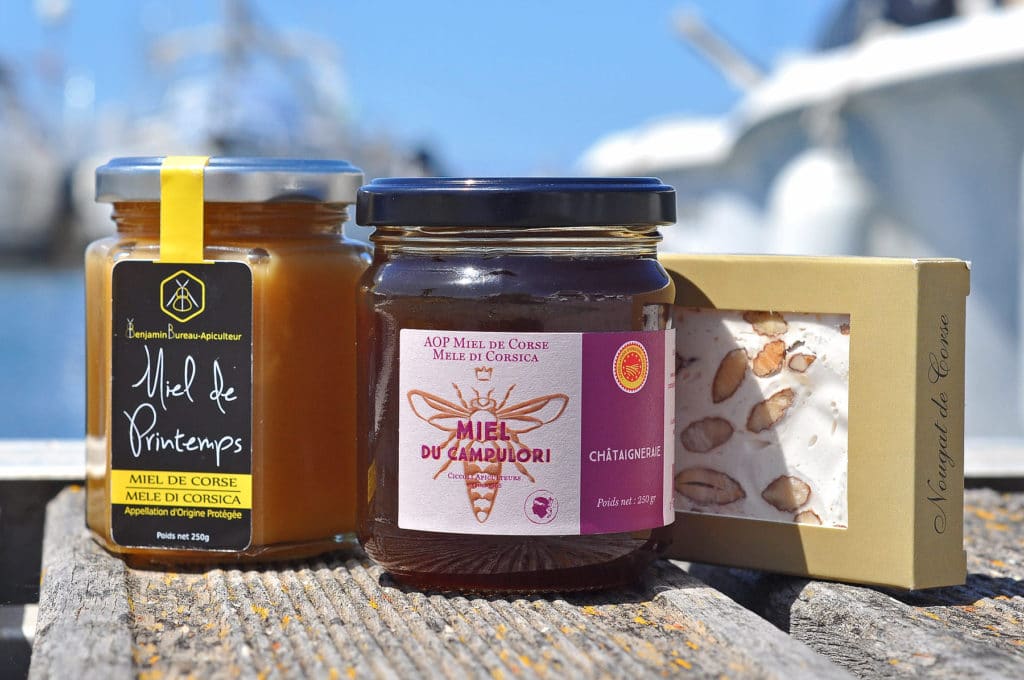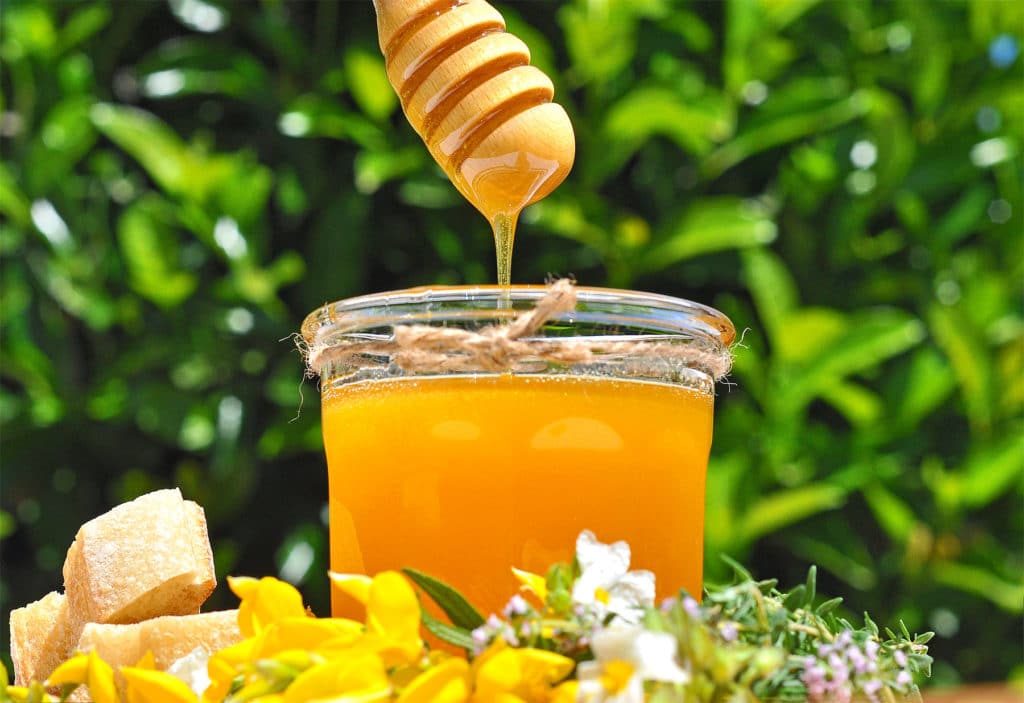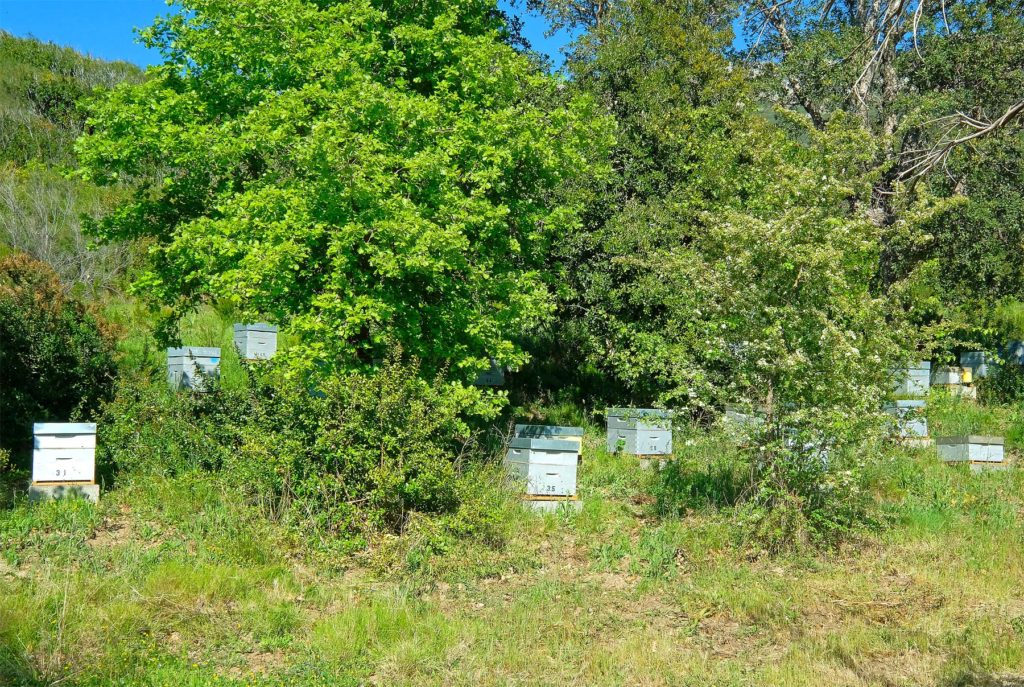
Savour top-quality Corsican honey sourced from the island’s rich, aromatic flora. Handcrafted in accordance with long-established beekeeping traditions, Miel de Corse offers a wide range of authentic flavours and aromas.
This page contains affiliate links meaning I get a commission if you decide to make a purchase through my links, at no extra cost to you. Click here to learn more.

CORSICAN HONEY
The production of Corsican honey dates back to Antiquity and is deeply rooted in the culinary traditions of the island. A symbol of wealth and happiness, honey has served as food and a source of valued medicinal therapy. In the past, apiculture was a very popular activity present throughout the entire territory, with most families possessing their own hives. Expert knowledge of bee biology and the functioning of a colony was passed on by subsequent generations of craftsmen who perfected their skills and adapted bee breeding to Corsica’s specific geographic conditions.
Modern-day Corsican honey is a sought-after gourmet product highly appreciated by connoisseurs. Certified in 1998 for its quality and origin with an AOC (Appellation d’Origine Controlée) label, it showcases an incomparable diversity of the island’s endemic vegetation. There are 6 different honey varieties within the appellation, each boasting unique flavours and aromas that reflect their true botanical origin. From pale and sweet to dark, amber-hued nectars, delicious Corsican honey caters to every palate, granting an exciting journey throughout the island’s distinct landscapes.

6 AOP HONEY VARIETIES
MIEL DE PRINTEMPS
Clear to golden floral nectar, free of acidity. From May, the honey is harvested in the orchards and plains of coastal regions from spring flowers- asphodels accompanied by willows and sea trefoil or clementines associated with rosehip and mimosas.
MIEL DE MAQUIS DE PRINTEMPS
Amber-hued honey with delicate caramel or cocoa flavours and an aroma of liquorice. Collected from the Corsican scrub (lavender, white heather, broom) in different geographic regions, it displays the wonderful complexity of the indigenous vegetation.
MIEL DE MIELLATS DU MAQUIS
Dark amber-coloured honey with aromas of liquorice, caramel and ripe fruit. The honeydews are harvested between May and September by the coast and in wooded areas accompanied by the maquis with the predominance of citrus, spiny broom, eucalyptus, and oak.
MIEL DE MAQUIS D’ETE
Aromatic light to clear amber-hued nectar with fruity and floral flavours. Harvested from August in Corsican high valleys, it is characterized by rare notes of anthyllis, brambles, thyme, and germander.
MIEL DE CHATAIGNERAIE
Strong, tannic, amber-coloured honey with a long finish and a hint of bitterness. Harvested at the end of June in the Corsican mountains, it showcases the complexity of the chestnut tree and the associated vegetation- clematis, broom, nepia, brambles, or anthyllis.
MIEL DE MAQUIS D’AUTOMNE
Bitter, strong honey with a clear amber hue and woody aromas. Harvested in November in various locations of the coastal regions and mountains of the interior, it reflects the flavours of arbutus, also known as the strawberry tree, associated with ivy, inula, and sarsaparilla.
ENJOY A CULINARY TOUR
Taste mouthwatering Corsican specialities during an exciting culinary tour of Ajaccio, Corsica’s capital city. A local guide will introduce you to artisanal products and dishes away from the tourist traps. Tastings last for up to 3 hours, and vegetarians are welcome.

AOP MIEL DE CORSE – MELE DI CORSICA — ESSENTIAL FACTS
- In 1998, in recognition of its typicality and quality, the Corsican honey was awarded an AOC (Appellation d’Origine Controlée) label, while in 2000, local beekeepers obtained its prestigious European equivalent, the AOP (Appellation d’Origine Protégée) certification.
- AOP Miel de Corse – Mele di Corsica must come from nectars or honeydew foraged by the Corsican bee on natural plant associations with the use of know-how reflecting centuries-old traditions and modern technical practices.
- There are 6 honey varieties within the appellation, offering a wide array of flavours and colours that showcase the fascinating complexity of the endemic habitats.
- The produced honey is subject to regular checks and controls, including laboratory analyses and sensory assessment, to certify the quality and origin of the product.
- The production practices, as well as the beehives, also undergo rigorous checks- hives must be maintained in good condition, waxes should be renewed regularly, and smoking must be carried out with natural fuels.
- Throughout the season, apiculturists move their hives to different locations, which enables the bees to discover new foraging sources- from citrus orchards on the coast to fragrant maquis and chestnut groves of the mountains.
- In addition to its unrivalled sensory and nutritional properties, Corsican honey has also played an important role in the conservation of the environment. Beekeeping ensures pollination of the island’s territory, which in turn helps to preserve biodiversity and stabilize fragile ecosystems.
- With the acquisition of quality accreditation, Corsican apiculture underwent intensive modernization and development. Today, along with the Fir honey of Vosges, Mele di Corsica is the only French honey to carry the AOC/AOP label.
- An extensive list of authorized beekeepers may be obtained from the official Corsican Honey Syndicate website mieldecorse.com/le-syndicat/les-apiculteurs-habilites-2/
CORSICAN BEE
The Corsican bee, Apis mellifera mellifera corsica, used within the appellation is a subspecies of the common European Apis mellifera. Characterized by a fairly small size and short hairs, it is perfectly adapted to its environment and the climatic conditions.
Specific to the island, it has been protected since 1982 by a decree that prohibits the importation and introduction of flocks to the territory. To support and preserve the local species, in 2005, the AOP Miel de Corse – Mele di Corsica Syndicat established a Corsican station for the selection and breeding of the bees.

PRODUCTION OF HONEY
Worker bees start their busy activity before sunrise when they set out to gather nectar and pollen from flowers with their straw-like tongue. Collected in a small sac called a crop, the sweet liquid gets enriched by enzymes, whereas water is drawn out. The process known as nectar-ripening continues on return to the hive where the sugar solution rich in vitamins and minerals is deposited into honeycomb cells. Other worker bees reingest the nectar, further reducing its moisture content to about 20%. Cells full of ripened honey are then sealed with a beeswax cap.
Honey supers filled with 8-10 frames are collected from the hives at the end of the flowering season specific for each type of honey. The film of wax that protects the cells is removed with an uncapping knife, and frames are placed in a centrifugal (spinning) extractor. Nectar deposited in stainless steel barrels is filtered to eliminate all impurities such as wax, propolis or pollen to be then put in jars ready for consumption.
BOOK A CULINARY/CULTURAL EXPERIENCE IN AJACCIO
Enjoy a Corsican meal while learning fascinating facts about the life of Napoleon Bonaparte at the Napoleon Cave. This comprehensive cultural experience may be booked in advance.
YOU MAY ALSO LIKE
- 7 Best Corsican wine & food pairings
- Celebrated wines of Patrimonio
- What to eat and drink in Corsica – traditional Corsican cuisine
- A guide to great Corsican cheeses
- 6 Iconic Corsican whites every wine lover should try
- 30 Summer fairs, festivals and events in Corsica
- Pietra – Corsican beer with character
- Corsican olive oil
- Enjoy Corsica’s best-loved dessert
- Delicious Brocciu – Corsica’s favourite cheese
